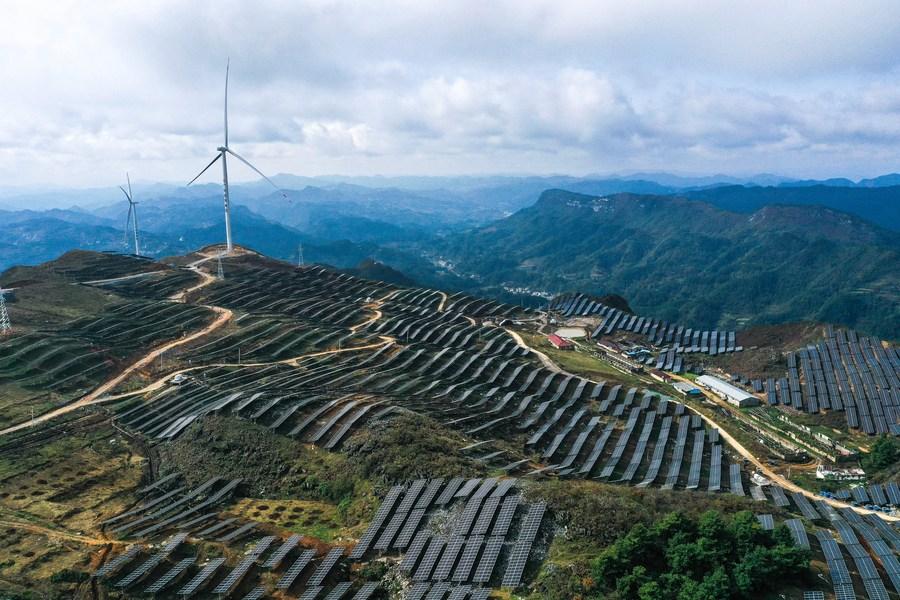Xinhua | December 29, 2023

This aerial photo taken on Nov. 16, 2023 shows the Dingdongpo wind power-photovoltaic project in Shiqian County of Tongren City, southwest China's Guizhou Province. (Xinhua/Yang Wenbin)
As 2023 draws to a close, the world has seen China leap forward in its transition to green and low-carbon development.
Conducive to global efforts to combat climate change, China has been investing heavily by leveraging its resources, technology and workforce to transform itself into an environmentally friendly country, and making strides to share its gains with the rest of the world.
The following are some facts and figures that show what China has achieved in its green shift over the past few years.
BOOMING RENEWABLE ENERGY SECTOR
China's renewable energy sector is gaining traction as the government strives to increase the proportion of electricity from non-fossil fuels in its energy structure.
In 2023, the country's renewable energy capacity, which includes wind power, solar power, hydropower and biomass energy, surpassed that of thermal power for the first time to constitute more than half of the country's installed power generation capacity.
Renewable energy currently accounts for about one-third of the country's total power consumption, with wind power and solar power combined accounting for more than 15 percent of total power use.
LOW CARBON
China has committed to the dual carbon goals of peaking carbon emissions by 2030 and achieving carbon neutrality by 2060.
To meet these goals, the country released an action plan to peak carbon emissions and announced another plan to select 100 carbon-peak pilot cities and industrial parks, with the first batch of 35 made public in November.
The world's second-largest economy saw its energy intensity, or energy consumption per unit of GDP, fall 0.4 percent year on year in the first half of 2023, with the pace of decline accelerating from the drop of 0.1 percent registered a year earlier.
Its carbon emissions intensity decreased more than 51 percent in 2022 from its 2005 level, according to a 2023 report on China's policies and actions to address climate change.
The country's low-carbon development has helped foster a thriving new energy vehicle (NEV) market, making it a global leader in the sector. Its production and sales of NEVs rank first in the world, accounting for more than half of the world's total, with more than 18 million NEVs in use domestically.
GREEN APPROACH
The country's green transformation of its industries and resident lifestyle has also made great strides, empowering high-quality and more sustainable development.
On a busy street in Nanjing, east China's Jiangsu Province, a "breathing" building attracts attention. It is the largest prefabricated zero-carbon building in Jiangsu. Its skeleton was constructed with wood and its rooftop photovoltaic panels are able to meet all the lighting, air conditioning and other electricity needs of the building, and it can also store surplus photovoltaic energy for the surrounding communities.
In parts of northern China, winter used to bring smoggy skies and suffocating air quality due to the extensive burning of coal for heating. However, the situation has changed drastically with the widespread adoption of clean energy heating.
In November 2022, the Hongyanhe Nuclear Power Station, the first nuclear power plant in northeast China, began providing heating to an area covering 242,400 square meters of residential property. It is estimated that the clean energy heating source can reduce carbon dioxide emissions by 14,100 tonnes per year.
In Beijing and Zhangjiakou, the 2022 Beijing Winter Olympics achieved a 100 percent renewable energy supply at Olympic venues. Five of the nine ice rinks in these venues used carbon dioxide to make ice, marking the first time a natural carbon dioxide refrigeration system has been used in the Olympics.
ANTI-POLLUTION
China has stepped up efforts to enhance its enforcement of environmental regulations, and doubled down on the fight against pollution and environmental degradation.
The country launched specific national campaigns to defend its blue skies, clear waters and clean land, and carried out environmental inspections nationwide. It also adopted the "river chief" and "lake chief" systems to safeguard the ecological environment of its rivers and lakes.
Last month, China's average PM2.5 density, a key indicator of air pollution, dropped 2.9 percent year on year, plunging 19.5 percent from the 2019 level.
An initial group of 180 officials was held accountable for environmental violations in the country's third environmental inspection campaign, which began last month.

